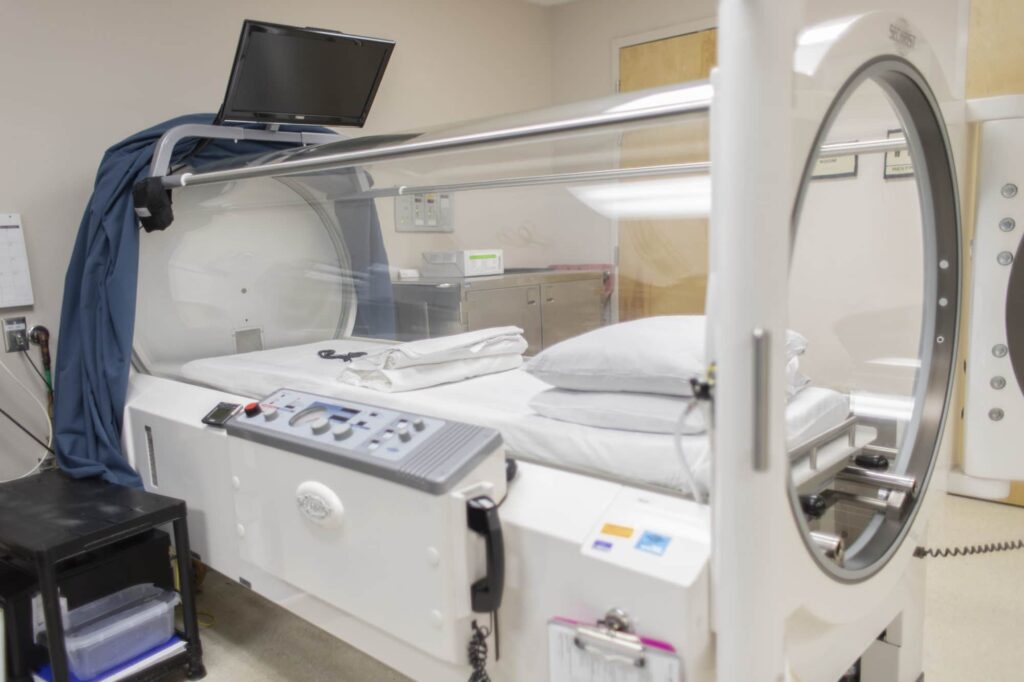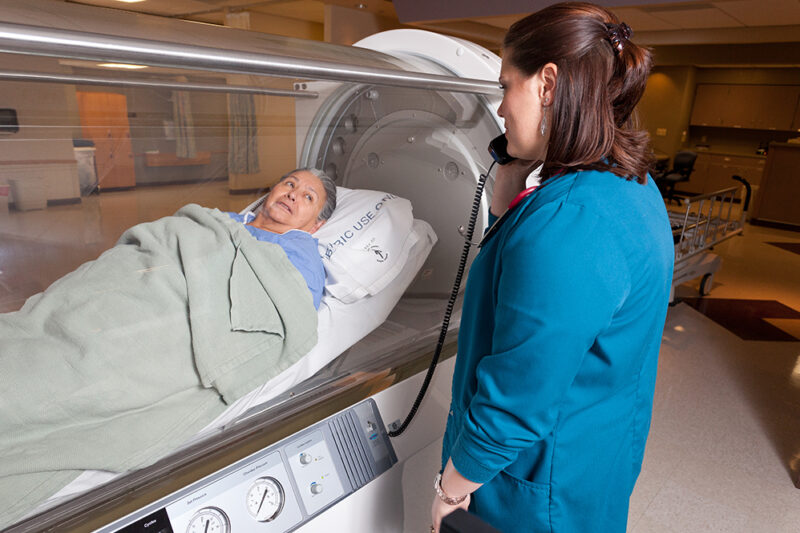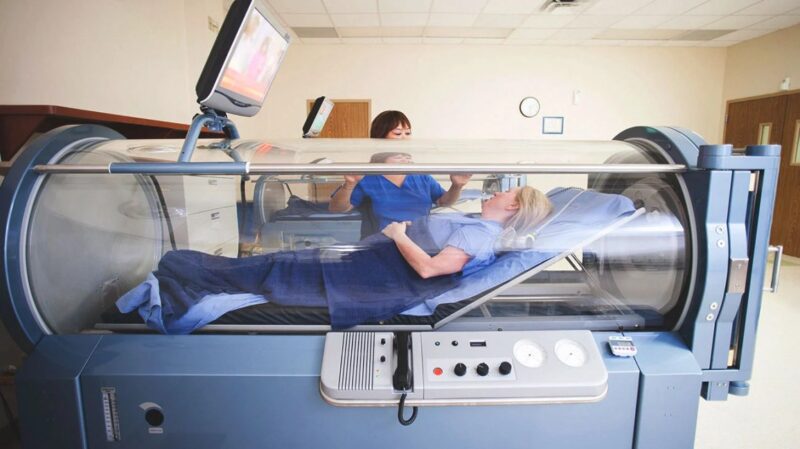The potential therapeutic advantages of hyperbaric chamber technology have garnered increasing interest in recent years for a range of medical ailments. This cutting-edge medical technology was first created to treat decompression sickness in divers, but it has since been used to treat neurological problems, sports recuperation, and wound healing. Gaining knowledge about the functions and advantages of hyperbaric chambers might help one better understand their place in contemporary healthcare.
Page Contents
Mechanism of Action

Hyperbaric oxygen treatment Los Angeles harnesses the therapeutic potential of pressurized environments to promote healing and tissue repair. Within a sealed hyperbaric chamber, individuals are exposed to increased atmospheric pressure, enabling their bodies to absorb higher levels of oxygen. This elevated oxygen delivery proves beneficial, particularly in areas with compromised blood flow or oxygenation. By stimulating cellular metabolism, reducing inflammation, and promoting the formation of new blood vessels, hyperbaric therapy facilitates tissue regeneration and accelerates the healing process.
One of the key mechanisms underlying hyperbaric therapy is the elevation of oxygen saturation levels in the blood and tissues. Under normal atmospheric conditions, oxygen is transported primarily by hemoglobin in red blood cells. However, in conditions such as ischemia or injury, tissues may experience inadequate oxygen supply, leading to cell damage or impaired healing. Hyperbaric oxygen therapy (HBOT) augments oxygen delivery independent of hemoglobin, ensuring sufficient oxygenation of tissues even in areas with compromised blood flow.
In addition to enhancing oxygen delivery, therapy exerts potent anti-inflammatory and antimicrobial effects. Elevated oxygen levels within tissues can suppress inflammatory pathways and reduce the production of reactive oxygen species, thereby mitigating tissue damage and promoting healing. Furthermore, the antimicrobial properties of hyperbaric oxygen create an inhospitable environment for certain bacteria and facilitate the clearance of infections, making it a valuable adjunctive treatment for various infectious and inflammatory conditions.
Clinical Applications
The versatility of hyperbaric chamber technology has led to its widespread adoption across diverse medical specialties. From wound care clinics to elite sports facilities, therapy is utilized to address a multitude of health concerns and optimize recovery outcomes. Understanding the breadth of its clinical applications underscores the significance of this innovative treatment modality in modern healthcare.
One of the primary applications is in the management of chronic wounds and tissue injuries. By enhancing oxygen delivery to compromised tissues, HBOT promotes angiogenesis, collagen synthesis, and fibroblast proliferation, essential processes for wound healing. This accelerated tissue repair can significantly reduce healing time and minimize the risk of complications, particularly in conditions such as diabetic ulcers, radiation-induced tissue damage, and non-healing wounds.
Emerging research suggests promising benefits of hyperbaric oxygen therapy in the management of neurological disorders, including traumatic brain injury (TBI) and stroke. By improving oxygenation and reducing inflammation in the brain, HBOT may help mitigate neuronal damage, enhance neuroplasticity, and facilitate recovery following acute brain injuries. While further studies are needed to elucidate its optimal use and long-term effects, hyperbaric therapy holds potential as a non-invasive adjunctive treatment for neurological conditions.
Advantages and Considerations

While hyperbaric chamber technology offers compelling therapeutic benefits, it is essential to consider both its advantages and limitations to ensure safe and effective utilization in clinical practice. Understanding the nuances of hyperbaric therapy can guide healthcare providers and patients in making informed decisions regarding its incorporation into treatment regimens.
One of the primary advantages is its non-invasive nature and excellent tolerability profile. Unlike surgical interventions or pharmacological therapies, HBOT does not require incisions or systemic medications, minimizing the risk of adverse effects and complications. Moreover, the pressurized chamber environment is carefully controlled, ensuring patient comfort and safety throughout the treatment session.
Despite its widespread applicability, hyperbaric therapy requires careful patient selection and adherence to standardized treatment protocols to optimize outcomes. Healthcare providers must assess the underlying condition, medical history, and contraindications before recommending HBOT. Additionally, adherence to prescribed treatment schedules and monitoring for potential side effects are critical aspects of ensuring safe and effective delivery.
Safety Considerations and Precautions
While hyperbaric chamber therapy is generally safe and well-tolerated, certain precautions must be observed to minimize potential risks. Patients with conditions such as untreated pneumothorax, chronic sinusitis, or uncontrolled seizure disorders may not be suitable candidates for HBOT due to the risk of complications. Moreover, individuals with claustrophobia or anxiety may require additional support or accommodations during treatment sessions to ensure their comfort and compliance. Healthcare providers must carefully assess each patient’s medical history and contraindications before initiating hyperbaric therapy to mitigate adverse outcomes and optimize treatment efficacy.
Cost and Accessibility

Despite its proven benefits, the cost can be a barrier to access for some patients. While insurance coverage may be available for certain approved indications, coverage policies vary widely among providers and regions. Additionally, the availability of facilities may be limited in certain areas, necessitating travel or relocation for individuals seeking treatment. As healthcare systems strive to improve accessibility and affordability, advocacy efforts, and research into cost-effective delivery models are essential to ensure equitable access to this valuable treatment modality.
Emerging Research and Future Directions
As the field of hyperbaric medicine continues to evolve, ongoing research efforts are exploring novel applications and refining treatment protocols to maximize therapeutic outcomes. From investigating the use of hyperbaric therapy in oncology to exploring its potential neuroprotective effects in neurodegenerative diseases, emerging studies are shedding light on new avenues for harnessing the benefits of increased oxygenation.
Furthermore, advancements in hyperbaric chamber technology, such as portable or wearable devices, hold promise for expanding access to hyperbaric therapy beyond traditional clinical settings. By embracing innovation and collaboration, researchers and clinicians can continue to push the boundaries of hyperbaric medicine and improve patient care.
Conclusion
In conclusion, hyperbaric chamber technology represents a remarkable advancement in medical science with far-reaching implications for healthcare. By harnessing the therapeutic potential of increased oxygenation, hyperbaric therapy offers a versatile and effective treatment modality for a wide range of conditions, from chronic wounds to neurological disorders. As research continues to elucidate its mechanisms of action and refine treatment protocols, hyperbaric chamber technology is poised to play an increasingly prominent role in promoting healing and enhancing patient outcomes across diverse clinical settings.






